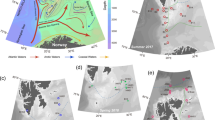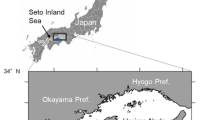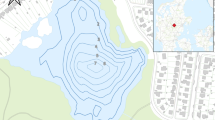Abstract
Diapause, which occurs through the production of dormant eggs, is a strategy used by some zooplankton to avoid winter months of persistent low temperatures and low food availability. However, reports of active zooplankton under the ice indicate that other strategies also exist. This study was aimed at evaluating whether the composition of storage lipids in the fall differs between diapausing and active overwintering Daphnia. We assessed the quantity of storage lipids and fatty acid (FA) composition of Daphnia species, along with FA content of seston, in six boreal, alpine and subarctic lakes at the onset of winter, and evaluated the association between storage lipids and Daphnia overwintering strategy. We found that active overwintering Daphnia had >55% body fat and the highest FA concentrations. Polyunsaturated FA, especially stearidonic acid (18:4n-3; SDA) and high ratios of n-3:n-6, were preferentially retained to a greater extent in active overwintering Daphnia than in those that entered diapause. Daphnia FA composition was independent of that of the seston diet, indicating that Daphnia adjusted their storage lipids according to the physiological requirements of a given overwintering strategy. The occurrence of an active overwintering strategy has consequences for zooplankton community structure, and can have important implications for the transfer of high-quality energy at higher trophic levels.


Similar content being viewed by others
Abbreviations
- FA:
-
Fatty acid(s)
- FAME:
-
Fatty acid methyl esters
- EPA:
-
Eicosapentaenoic acid, 20:5n-3
- MUFA:
-
Monounsaturated fatty acid(s)
- PUFA:
-
Polyunsaturated fatty acid(s)
- SDA:
-
Stearidonic acid, 18:4n-3
- SFA:
-
Saturated fatty acid(s)
References
Thackeray SJ, Henrys PA, Jones ID, Feuchtmayr H (2012) Eight decades of phenological change for a freshwater cladoceran: what are the consequences of our definition of seasonal timing? Freshw Biol 57:345–359. doi:10.1111/j.1365-2427.2011.02614.x
Chen C, Folt C (1996) Consequences of fall warming for zooplankton overwintering success. Limnol Oceanogr 41:1077–1086
Hagen W, Auel H (2001) Seasonal adaptations and the role of lipids in oceanic zooplankton. Zoology (Jena) 104:313–326. doi:10.1078/0944-2006-00037
Lampert W, Lampert KP, Larsson P (2010) Coexisting overwintering strategies in Daphnia pulex: a test of genetic differences and growth responses. Limnol Oceanogr 55:1893–1900. doi:10.4319/lo.2010.55.5.1893
Larsson P, Wathne I (2006) Swim or rest during the winter—what is best for an alpine daphnid? Arch für Hydrobiol 167:265–280. doi:10.1127/0003-9136/2006/0167-0265
Slusarczyk M (2009) Extended lifespan traded for diapause in Daphnia. Freshw Biol 54:2252–2262. doi:10.1111/j.1365-2427.2009.02256.x
Rautio M, Mariash H, Forsström L (2011) Seasonal shifts between autochthonous and allochthonous carbon contributions to zooplankton diets in a subarctic lake. Limnol Oceanogr 56:1513–1524. doi:10.4319/lo.2011.56.4.1513
Schneider T, Grosbois G, Vincent WF, Rautio M (2016) Carotenoid accumulation in copepods is related to lipid metabolism and reproduction rather than to UV-protection. Limnol Ocean. doi:10.1002/lno.10283
Carvalho GR, Hughes RN, Animal S (1983) The effect of food availability, female culture-density and photoperiod on ephippia production in Daphnia magna Straus (Crustacea: Cladocera). Freshw Biol 13:37–46. doi:10.1111/j.1365-2427.1983.tb00655.x
Griffiths D, Kirkwood RC (1995) Seasonal variation in growth, mortality and fat stores of roach and perch in Lough Neagh, Northern Ireland. J Fish Biol 47:537–554
Hagen W, Van Vleet E, Kattner G (1996) Seasonal lipid storage as overwintering strategy of Antarctic krill. Mar Ecol Prog Ser 134:85–89. doi:10.3354/meps134085
Tessier AJ, Goulden CE (1982) Estimating Food Limitation in Cladoceran Populations. Limnol Oceanogr 27:707–717
Reznick DN, Braun B (1987) Fat cycling in the mosquitofish (Gambusia affinis): fat storage as a reproductive adaptation. Oecologia 73:401–413. doi:10.1007/BF00385257
Lee RF, Hagen W, Kattner G (2006) Lipid storage in marine zooplankton. Mar Ecol Prog Ser 307:273–306
van der Meeren T, Olsen RE, Hamre K, Fyhn HJ (2008) Biochemical composition of copepods for evaluation of feed quality in production of juvenile marine fish. Aquaculture 274:375–397. doi:10.1016/j.aquaculture.2007.11.041
Hiltunen M, Strandberg U, Keinänen M et al (2014) Distinctive lipid composition of the copepod Limnocalanus macrurus with a high abundance of polyunsaturated fatty acids. Lipids 919–932. doi:10.1007/s11745-014-3933-4
Kattner G, Hagen W, Lee RF et al (2007) Perspectives on marine zooplankton lipids. Can J Fish Aquat Sci 64:1628–1639. doi:10.1139/F07-122
Guschina IA, Harwood JL (2009) Algal lipids and effect of the environment on their biochemistry. In: Arts MT, Brett MT, Kainz MJ (eds) Lipids Aquat Ecosyst. Springer, New York, pp 1–24
Persson J, Vrede T (2006) Polyunsaturated fatty acids in zooplankton: variation due to taxonomy and trophic position. Freshw Biol 51:887–900. doi:10.1111/j.1365-2427.2006.01540.x
Müller-Navarra DC, Brett MT, Liston AM, Goldman CR (2000) A highly unsaturated fatty acid predicts carbon transfer between primary producers and consumers. Nature 403:74–77. doi:10.1038/47469
Yang XW, Dick TA (1994) Arctic char (Salvelinus Alpinus) and rainbow trout (Oncorhynchus Mykiss) differ in their growth and lipid metabolism in response to dietary polyunsaturated fatty acids. Can J Fish Aquat Sci 51:1391–1400
Burns CW, Brett MT, Schallenberg M (2011) A comparison of the trophic transfer of fatty acids in freshwater plankton by cladocerans and calanoid copepods. Freshw Biol 56:889–903. doi:10.1111/j.1365-2427.2010.02534.x
Taipale SJ, Kainz MJ, Brett MT (2011) Diet-switching experiments show rapid accumulation and preferential retention of highly unsaturated fatty acids in Daphnia. Oikos 120:1674–1682. doi:10.1111/j.1600-0706.2011.19415.x
Eloranta AP, Mariash HL, Rautio M, Power M (2013) Lipid-rich zooplankton subsidise the winter diet of benthivorous Arctic charr (Salvelinus alpinus) in a subarctic lake. Freshw Biol 58:2541–2554. doi:10.1111/fwb.12231
Hampton SE, Moore MV, Ozersky T et al (2015) Heating up a cold subject: prospects for under-ice plankton research in lakes. J Plankton Res 0:1–8. doi:10.1093/plankt/fbv002
Dufresne F, Hebert PDN (1995) Polyploidy and clonal diversity in an arctic cladoceran. Heredity (Edinb) 75:45–53
Rautio M, Sorvari S, Korhola A (2000) Diatom and crustacean zooplankton communities, their seasonal variability and representation in the sediments of subarctic Lake Saanajärvi. Methods 59:81–96
Heissernberger M, Watzke J, Kainz MJ (2010) Effect of nutrition on fatty acid profiles of riverine, lacustine, and aquaculture-raised salmonids of pre-alpine habitats. Hydrobiology 650:234–254
Fairclough DV, Clarke KR, Valesini FJ, Potter IC (2008) Habitat partitioning by five congeneric and abundant Choerodon species (Labridae) in a large subtropical marine embayment. Estuarine Coast Shelf Sci 77:446–456. doi:10.1016/j.ecss.2007.10.004
Holm S (1979) A simple sequentially rejective multiple test procedure. Scand J Stat 6:65–70
Ahlgren G, Vrede T, Geodkoop W (2009) Fatty acid ratios in freshwater fish, zooplankton and zoobenthos. In: Arts MT, Brett MT, Kainz MJ (eds) Lipids Aquat Ecosyst. Springer, New York, pp 147–178
Hessen DO, Leu E (2006) Trophic transfer and trophic modification of fatty acids in high Arctic lakes. Freshw Biol 51:1987–1998. doi:10.1111/j.1365-2427.2006.01619.x
Brett MT, Mu C, Ballantyne AP et al (2006) Daphnia fatty acid composition reflects that of their diet. Limnol Oceanogr 51:2428–2437
Galloway AWE, Taipale SJ, Hiltunen M et al (2014) Diet-specific biomarkers show that high-quality phytoplankton fuels herbivorous zooplankton in large boreal lakes. Freshw Biol 59:1902–1915. doi:10.1111/fwb.12394
Sarma SSS, Nandini S, Gulati RD (2005) Life history strategies of cladocerans: comparisons of tropical and temperate taxa. Hydrobiologia 542:315–333. doi:10.1007/s10750-004-3247-2
Cáceres CE, Tessier AJ (2004) To sink or swim: variable diapause strategies among Daphnia species. Limnol Oceanogr 49:1333–1340. doi:10.4319/lo.2004.49.4_part_2.1333
de Senerpont Domis LN, Mooij WM, Hülsmann S et al (2007) Can overwintering versus diapausing strategy in Daphnia determine match-mismatch events in zooplankton–algae interactions? Oecologia 150:682–698. doi:10.1007/s00442-006-0549-2
Demott W, Müller-Navarra D (1997) The importance of highly unsaturated fatty acids in zooplankton nutrition: evidence from experiments with Daphnia, a cyanobacterium and lipid emulsions. Freshw Biol 38:649–664. doi:10.1046/j.1365-2427.1997.00222.x
Von Elert E (2004) Food quality constraints in Daphnia: interspecific differences in the response to the absence of a long chain polyunsaturated fatty acid in the food source. Hydrobiologia 526:187–196. doi:10.1023/B:HYDR.0000041604.01529.00
Patalas K (1990) Diversity of zooplankton communities in Canadian lakes as a function of climate. Verhanlungen des Int verein für Limnol 24:360–368
Forsström L, Sorvari S, Rautio M et al (2007) Changes in physical and chemical limnology and plankton during the spring melt period in a Subarctic Lake. Int Rev Hydrobiol 92:301–325. doi:10.1002/iroh.200610928
Roiha T, Laurion I, Rautio M (2015) Carbon dynamics in highly heterotrophic subarctic thaw ponds. Biogeosciences 12:7223–7237. doi:10.5194/bg-12-7223-2015
Farkas T, Herodek S (1964) The effect of environmental temperature on the fatty acid composition of crustacean plankton. J Lipid Res 5:369–373
Dufresne F, Hebert PDN (1998) Temperature-related differences in life-history characteristics between diploid and polyploid clones of the Daphnia pulex complex 1. Ecoscience 5:433–437
Gliwicz M, Slusarczyk A, Slusarczyk M (2001) Life history synchronization in a long-lifespan single-cohort Daphnia population in a fishless alpine lake. Oecologia 128:368–378. doi:10.1007/s004420100673
Tessier AJ, Henry L, Goulden CE, Durand MW (1983) Starvation in Daphnia: energy reserves and reproductive allocation. Limnol Oceanogr 28:667–676
Hartwich M, Martin-Creuzburg D, Wacker A (2013) Seasonal changes in the accumulation of polyunsaturated fatty acids in zooplankton. J Plankton Res 35:121–134. doi:10.1093/plankt/fbs078
Lampert W, Fleckner W, Rai H, Taylor BE (1986) A study zooplankton: on the phytoplankton control by grazing spring phase. Limnol Oceanogr 31:478–490
Dupuis AP, Hann BJ (2009) Climate change, diapause termination and zooplankton population dynamics: an experimental and modelling approach. Freshw Biol 54:221–235. doi:10.1111/j.1365-2427.2008.02103.x
Acknowledgements
We are grateful to the Kilpisjärvi and Simoncouche biological stations for logistical support. We thank Martin Kainz and Jorge Watzke at the Wasserkluster Lunz for technical support during FA analysis, and two anonymous reviewers for their constructive comments that improved the paper. Core funding was provided by the Academy of Finland with Grants 19205 and 140775 to MR.
Author information
Authors and Affiliations
Corresponding author
Electronic supplementary material
Below is the link to the electronic supplementary material.
About this article
Cite this article
Mariash, H.L., Cusson, M. & Rautio, M. Fall Composition of Storage Lipids is Associated with the Overwintering Strategy of Daphnia . Lipids 52, 83–91 (2017). https://doi.org/10.1007/s11745-016-4219-9
Received:
Accepted:
Published:
Issue Date:
DOI: https://doi.org/10.1007/s11745-016-4219-9




